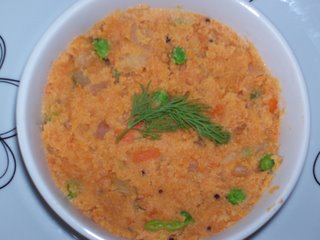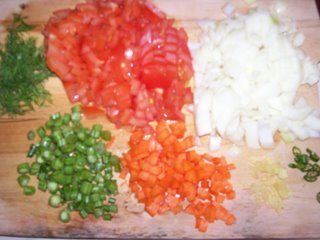Uppittu is a very common breakfast item in south India. They are usually prepared with semolina. Mom always used to make Upma with Avalakki.They are like ever bonded twins.
There are various ways of making upma and ofcourse im posting the recipe which I learnt from my mom. You can use couscous or vermicelli instead of semolina.
There are various ways of making upma and ofcourse im posting the recipe which I learnt from my mom. You can use couscous or vermicelli instead of semolina.
Ingredients:
2 cups Rava
4-5 cups water
2 medium onion chopped
2 large ttomatoes, chopped
2-4 green chilies sliced
1 inch piece of grated ginger
1 cup vegetables (carrots, green peas, green beans)
Asafoetida
1 tsp mustard seeds
2 tsp urad dal
3 tsp oil
1 lemon
Salt to taste
1 inch piece of grated ginger
1 cup vegetables (carrots, green peas, green beans)
Asafoetida
1 tsp mustard seeds
2 tsp urad dal
3 tsp oil
1 lemon
Salt to taste
Method:
Dry roast the rava with little ghee or oil until you can smell the aroma but don't let it burn.
Heat the oil in a thick saucepan.
Add the mustard seeds and after they pop add the urad dal.
When it turns slightly brown add green chilies and onion and saute till it softens.
Next add the chopped tomtomatoes and cook them for 3 minutes.
mix in the vegetables and saute for 3 minutes.
Add 4 cups of water, salt and hing.
When the water boils add the rava while stirring constantly.
After 2 or 3 min, cover the pan and cook over a low flame for 7 minutes.
Serve hot or warm.
Add 4 cups of water, salt and hing.
When the water boils add the rava while stirring constantly.
After 2 or 3 min, cover the pan and cook over a low flame for 7 minutes.
Serve hot or warm.

Tip:
Use couscous/vermicelli instead of Rava as shown above
Use couscous/vermicelli instead of Rava as shown above




